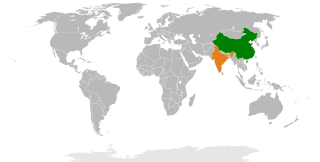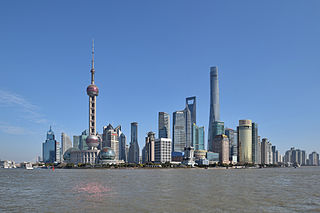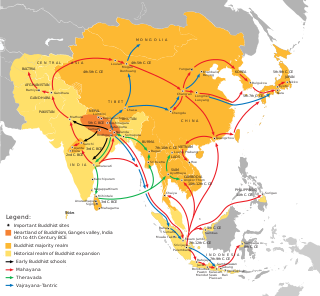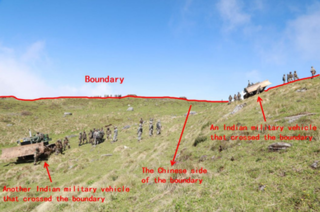See also
| This article includes a list of roads, streets, highways, or other routes that are associated with the same title. If an internal link led you here, you may wish to change the link to point directly to the intended article. |
Not to be confused with Chinese Road in Laotian Civil War
Roads in China may refer to:
| This article includes a list of roads, streets, highways, or other routes that are associated with the same title. If an internal link led you here, you may wish to change the link to point directly to the intended article. |

The Sino-Indian War, also known as the Indo-China War and Sino-Indian Border Conflict, was a war between China and India that occurred in 1962. A Chinese disputed Himalayan border was the main cause of the war. There had been a series of violent border skirmishes between the two countries after the 1959 Tibetan uprising, when India granted asylum to the Dalai Lama. India initiated a defensive Forward Policy from 1960 to hinder Chinese military patrols and logistics, in which it placed outposts along the border, including several north of the McMahon Line, the eastern portion of the Line of Actual Control proclaimed by Chinese Premier Zhou Enlai in 1959.

A highway is any public or private road or other public way on land. It is used for major roads, but also includes other public roads and public tracks: It is not an equivalent term to controlled-access highway, or a translation for autobahn, autoroute, etc.

The Silk Road was a network of trade routes which connected the East and West, and was central to the economic, cultural, political, and religious interactions between these regions from the 2nd century BCE to the 18th century. The Silk Road primarily refers to the land routes connecting East Asia and Southeast Asia with South Asia, Persia, the Arabian Peninsula, East Africa and Southern Europe.

Aksai Chin is a region that is administered by China as part of its Xinjiang and Tibet autonomous regions and claimed by India as part of the union territory of Ladakh. It is in the eastern portion of the larger Kashmir region which has been the subject of the Kashmir conflict since 1947 and the Sino-Indian border dispute since 1962.

Ürümqi or Urumchi, abbreviated Wushi, formerly known as Tihwa, is the capital of the Xinjiang Uyghur Autonomous Region in the far northwest of the People's Republic of China. Ürümqi was a major hub on the Silk Road during China's Tang dynasty and developed its reputation as a leading cultural and commercial center during the Qing dynasty in the 19th century.

The Taklamakan Desert is a desert in Southwest Xinjiang in Northwest China. It is bounded by the Kunlun Mountains to the south, the Pamir Mountains and Tian Shan to the west and north and the Gobi Desert to the east.

Pudong is a district of Shanghai located east of the Huangpu River across from the historic city center of Shanghai in Puxi. The name refers to its historic position as "The East Bank" of the Huangpu River, which flows through central Shanghai, although it is now administered as the Pudong New Area, a state-level new area which extends all the way to the East China Sea.

The Shanghai Metro is a rapid transit system in Shanghai, operating urban and suburban transit services to 14 of its 16 municipal districts and to Huaqiao Town, Kunshan, Jiangsu Province. Opening in 1993 with full-scale construction extending back to 1986, the Shanghai Metro is the third-oldest rapid transit system in mainland China, after the Beijing Subway and the Tianjin Metro. It has seen substantial growth, significantly during the years leading up to the Expo 2010, and is still expanding quickly, with its most recent expansions having opened in December 2018. It is the biggest component of the Shanghai metropolitan rail transit network, together with the Shanghai maglev train, the Zhangjiang Tram, the Songjiang Tram and the China Railway-operated commuter rail services to Jinshan. The metro system is also integrated with other forms of public transport in Shanghai.

The Karakoram Highway is a 1,300 km (810 mi) national highway which extends from Hasan Abdal in the Punjab province of Pakistan to the Khunjerab Pass in Gilgit-Baltistan, where it crosses into China and becomes China National Highway 314. The highway connects the Pakistani provinces of Punjab and Khyber Pakhtunkhwa plus Gilgit-Baltistan with China's Xinjiang Uyghur Autonomous Region. The highway is a popular tourist attraction and is one of the highest paved roads in the world, passing through the Karakoram mountain range, at 36°51′00″N75°25′40″E at maximum elevation of 4,714 m (15,466 ft) near Khunjerab pass. Due to its high elevation and the difficult conditions in which it was constructed, it is often referred to as the Eighth Wonder of the World. The highway is also a part of the Asian Highway AH4.

Buddhism entered Han China via the Silk Road, beginning in the 1st or 2nd century CE. The first documented translation efforts by Buddhist monks in China were in the 2nd century CE via the Kushan Empire into the Chinese territory bordering the Tarim Basin under Kanishka. These contacts transmitted strands of Sarvastivadan and Tamrashatiya Buddhism throughout the Eastern world.

UAE Team Emirates is an Emirati road bicycle racing team. The team competes at UCI WorldTeam level and has done so since the UCI World Tour was formed as the top category of road cycling in 2005. However the team was temporarily suspended from the ProTour in 2010, missing one ProTour event.

Battle of Northern Burma and Western Yunnan was the name of the Chinese campaign with their allies in the 1943–45 Burma Campaign. The campaign ended in an Allied victory.

Sovereignty over two relatively large and several smaller separated pieces of territory has been contested between China and India. Aksai Chin is located either in the Indian union territory of Ladakh or the Chinese autonomous region of Xinjiang. It is a virtually uninhabited high-altitude wasteland crossed by the Xinjiang-Tibet Highway. The other disputed territory lies south of the McMahon Line. It was formerly referred to as the North East Frontier Agency, and is now called Arunachal Pradesh. The McMahon Line was part of the 1914 Simla Convention between British India and Tibet, without the agreement of China.

Beijing, alternatively romanized as Peking, is the capital of the People's Republic of China. It is the world's most populous capital city, with over 21 million residents within an administrative area of 16,410.5 km2. The city, located in North China, is governed as a municipality under the direct administration of the central government with 16 urban, suburban, and rural districts. Beijing is mostly surrounded by Hebei Province with the exception of neighboring Tianjin to the southeast; together, the three divisions form the Jingjinji megalopolis and the national capital region of China. Beijing is an important world capital and global power city, and one of the world's leading centers for culture, diplomacy and politics, business and economy, education, language, and science and technology. A megacity, Beijing is the second largest Chinese city by urban population after Shanghai and is the nation's cultural, educational, and political center. It is home to the headquarters of most of China's largest state-owned companies and houses the largest number of Fortune Global 500 companies in the world, as well as the world's four biggest financial institutions. It is also a major hub for the national highway, expressway, railway, and high-speed rail networks. The Beijing Capital International Airport has been the second busiest in the world by passenger traffic since 2010, and, as of 2016, the city's subway network is the busiest and longest in the world.

Xinjiang, officially the Xinjiang Uyghur Autonomous Region (XUAR), is an autonomous region of the People's Republic of China, located in the northwest of the country. Being the largest province-level division of China and the 8th largest country subdivision in the world, Xinjiang spans over 1.6 million km2. The Aksai Chin region, administered by China mostly as part of Xinjiang's Hotan Prefecture, is claimed by India. Xinjiang borders the countries of Mongolia, Russia, Kazakhstan, Kyrgyzstan, Tajikistan, Afghanistan (Badakhshan). The rugged Karakoram, Kunlun and Tian Shan mountain ranges occupy much of Xinjiang's borders, as well as its western and southern regions. Xinjiang also borders the Tibet Autonomous Region and the provinces of Gansu and Qinghai. The most well-known route of the historical Silk Road ran through the territory from the east to its northwestern border.
Arunachal Frontier Highway, also Mago-Thingbu–Vijaynagar Border Highway, is a planned border highway in the Indian state of Arunachal Pradesh. The 2,000-kilometre-long (1,200 mi) road follows the McMahon Line, the international border between India and China. The Government of India estimates the cost at ₹40,000 crore.
The Belt and Road Initiative, formerly known as One Belt One Road (OBOR) (Chinese:一带一路), is a global development strategy adopted by the Chinese government in 2013 involving infrastructure development and investments in nearly 70 countries and international organizations. It is considered a centerpiece of Xi Jinping's foreign policy.

The 2017 China India border standoff or Doklam standoff refers to the military border standoff between the Indian Armed Forces and the People's Liberation Army of China over Chinese construction of a road in Doklam near a trijunction border area, known as Donglang, or Donglang Caochang, in Chinese. On 16 June 2017 Chinese troops with construction vehicles and road-building equipment began extending an existing road southward in Doklam, a territory which is claimed by both China as well as India's ally Bhutan. On 18 June 2017, as part of Operation Juniper, about 270 Indian troops armed with weapons and two bulldozers crossed the Sikkim border into Doklam to stop the Chinese troops from constructing the road. On 28 August, both India and China announced that they had withdrawn all their troops from the face-off site in Doklam.
Debt trap diplomacy is used to describe a type of diplomacy based on debt carried out in the bilateral relations between countries with an often alleged negative intent. It involves one creditor country intentionally extending excessive credit to another debtor country with the alleged intention of extracting economic or political concessions from the debtor country when it becomes unable to honour its debt obligations. The conditions of the loans are often not made public with the loaned money often used to pay contractors from the creditor country. Although the term applies to the lending practices of many countries, it is currently most commonly associated with the Peoples Republic of China.

The 2020 China–India skirmishes are part of an ongoing military standoff between China and India. Since 5 May 2020, Chinese and Indian troops have reportedly engaged in aggressive melee, face-offs and skirmishes at locations along the Sino-Indian border, including near the disputed Pangong Lake in Ladakh and the Tibet Autonomous Region, and near the border between Sikkim and the Tibet Autonomous Region. Additional clashes are ongoing at locations in eastern Ladakh along the Line of Actual Control (LAC) that has persisted since the 1962 Sino-Indian War.